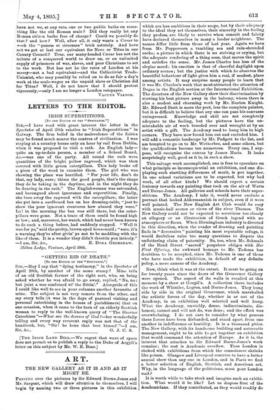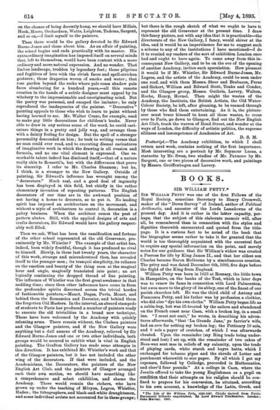ART.
THE NEW GALLERY AS IT IS AND AS IT MIGHT BE. Rissnna over the pictures by Sir Edward Burne-Jones and Mr. Sargent, which will draw attention to themselves, I will begin by naming two or three pictures in this exhibition
which are less ambitious in their scope, but by their adequacy to the ideal they set themselves, their sincerity in the feeling they profess, are likely to survive when conceit and falsity have declared themselves in many a louder neighbour. The names differ little from those of last year. Again we have from Mr. Peppercorn a tumbling sea and rain-shrouded rocks ; a picture in which there is no striving or crying, but the adequate rendering of a thing seen, that moves the spirit and satisfies the sense. Mr. James Charles has less of the elegiac mood ; his emotion is that of cheerful daylight upon ordinary scenes ; but the justice with which he observes the beautiful behaviour of light gives him a real, if modest, place among artists. It may surprise many people to learn that it was Mr. Charles's work that most attracted the attention of Degas in the English section at the International Exhibition. The directors of the New Gallery show their discrimination by stowing his best picture away in the balcony, where there is also a modest and charming work by Mr. Buxton Knight. Mr. Edward Stott is more the poet, less the complete painter, but it is difficult to believe that any one can pass his canvases unimpressed. Knowledge and skill are not completely adequate to the feeling, but the pictures have the un- mistakable air of work brooded over and wrought at by an artist with a gift. The Academy used to hang him in high corners. They have now found him out and excluded him. I will add a romantic landscape by Mr. Padgett to the list, and am tempted to go on to Mr. Wetherbee, and some others, but the qualifications become too numerous. Every one, I sup- pose, will recognise the canvas by James Maria. It looks surprisingly well, good as it is, in such a show.
This salvage work accomplished, one is free to speculate on what principle so inconsequential an exhibition, and one dis- playing such startling differences of merit, is put together. In one school variations are to be expected, but why bad work, of all other kinds? We should expect a certain leniency towards any painting that took on the air of Watts and Burne-Jonee. All galleries and schools have their super- stitions. The Academy, I take it, would never exclude a portrait that looked Aldermannish in subject, even if it were well painted. The New English Art Club would .be easy with music-hall scenes or views of the river Thames. The New Gallery could not be expected to scrutinise too closely an allegory or an illustration of Greek legend with no atmosphere or focus. When Birmingham industry is diverted in this direction, when the evader of drawing and painting finds in " decorative " painting his most reputable refuge, it would doubtless raise too many questions to dispute the unflattering claim of paternity. So, too, when Mr. Schmalz of the Bond Street "sacred" peepshow obliges with Her First Offering, the awkward homage to Mr. Tadema has doubtless to be accepted, since Mr. Tadema is one of those who have made the exhibition, in default of any definite policy, a mere annexe of the Academy.
Now, think what it was at the outset. It must be going on for twenty years since the doors of the Grosvenor Gallery were opened. The aspect of its walls is recalled at this moment by a show at Goupil's. A collection there includes the work of Whistler, Legros, and Burne-Jones. They hung side by side in the original Grosvenor, which marshalled the artistic forces of the day, whether in or out of the Academy, in an exhibition well selected and well hung. What the Academy, unwieldy, dense, indiscriminate, dis- honest, cannot and will not do, was done ; and the effect was overwhelming. I do not care to consider by what process these forces have been disbanded, and stand apart from one another in indifference or hostility. It is a thousand pities. The New Gallery, with its handsome building and autocratic management, ought to be able to get together an exhibition that would command the attention of Europe. As it is, the interest that attaches to Sir Edward Burne-Jones's work remains ; the rest is Academic overflow. Thus London is choked with exhibitions from which the connoisseur shrinks like poison. Glasgow and Liverpool contrive to have a better annual show than any one in London, and in Paris we find a better selection of English, Scottish, and American art. Why, in the language of the politicians, must poor London wait?
It is worth while to take stock and imagine such an exhibi- tion. What would it be like? Let us dispose first of the Academicians. If they contributed, as they would readily do
on the chance of being decently hung, we should have Millais, Hook, Moore, Orchardson, Watts, Leighton, Tadema, Sargent, and so on,—I limit myself to the painters.
Then there would be the gallery devoted to Sir Edward Borne-Jones and those about him. As an affair of painting, the school begins and ends practically with its master. His extraordinary imagination has imposed itself on several minds that, left to themselves, would have been content with a more ordinary and more natural expression. And no wonder. That limbns landscape, trodden by legendary feet ; those pilgrims and fugitives of love with the elvish faces and spell-stricken gestures ; those draperies woven of smoke and water ; that rose garden beyond the rocks where pale roses shadow pale faces slumbering for a hundred years,—all this remote creation in the hands of a subtle designer must appeal by its witchery to the impressionable and unoriginating mind. But the poetry was personal, and escaped the imitator ; he only reproduced the inadequacies of the painter. " Decorative " painting appeals to those who wish to learn to paint without having learned to see. Mr. Walter Crane, for example, used to make gay little decorations for children's books. Never able to draw in any serious sense of the word, he could cari- cature things in a pretty and jolly way, and arrange them with a dainty feeling for design. But the spell of a stronger personality descended on him ; he took to writing verses that no man could ever read, and to executing dismal caricatures of imaginative work in which the drawing is all evasion and formula, and no one vital element is expressed. One re- markable talent indeed has disclosed itself,—that of a nature really akin to Rossetti's, but with the differences that prove its sincerity. I refer to Mr. Charles Shannon; but he, I think, is a stranger to the New Gallery. Outside of painting, Sir Edward's influence has wrought among the "decorators." Much zeal, and a good deal of ingenuity has been displayed in this field, but chiefly in the rather elementary invention of repeating patterns. The English decorators of our time are in the awkward position of not having a house to decorate, so to put it. No leading spirit has imposed an architecture on the movement, and without -a style of architecture to control it, decoration is a paltry business. When the architect comes the pest of pattern abates. Still, with the applied designs of arts and crafts decorators, Sir Edward would have his gallery respect- ably well filled.
Then we ask, What has been the ramification and fortune of the other school represented at the old Grosvenor, pre- eminently by Mr. Whistler ? The example of that artist has, indeed, been widely fruitful, though it has produced no rival to himself. Slowly, in these last twenty years, the character of this work, strange and misunderstood then, has revealed itself to the younger men ; its tranquil simplicity, its reliance on the emotion and beauty of the thing seen at the magical hour and angle, magically translated into paint ; an art logically continuing the dropped thread of fine painting. The influence of Whistler was the first great awakener in that nodding time ; since then other influences have come in from the profonnder spirits discerned across the trivial hordes of fashionable painters,—Manet, Degas, Pavia, Monet, and behind them the Romantics and Danmier, and behind them the forgotten Old Masters. In the interval, an absurd stampede of students to Paris has produced a number of painters ready to execute the old trivialities in a brand new technique. These have been welcomed by the Academy with quickly relenting arms. There remain without, the Chelsea painters and the Glasgow painters, and if the New Gallery were anything but a dull annexe of the Academy, relieved by Sir Edward Barne-Jones and one or two other individuals, both groups would be secured to exhibit what is vital in English painting. The Grafton Gallery has made some attempts in this direction. It has exhibited Mr. Whistler's work and that of the Glasgow painters, but it has not included the other wing of the decorators. If that were included, and the Academicians, the Decorators, the painters of the New English Art Club, and the painters of Glasgow arranged each their own section, we should have something like a comprehensive and select exhibition, and shame the Academy. There would remain the etchers, who have grown up under the teaching of Meryon, Legros, Whistler, Haden ; the lithographers, and black-and-white draughtsmen, and some individual artists not accounted for in these groups;
but there is the rough sketch of what we ought to have tc represent the old Grosvenor at the present time. I draw this fancy picture, not with any idea that it is practicable—the directorate of the New Gallery, I fancy, would shiver at the idea, and it would be an impertinence for me to suggest such a scheme to any of the institutions I have mentioned—I do it to remind my readers of the sort of exhibition London once had and ought to have again. To come away from this in- consequent New Gallery, and to be on the eve of the opening of another Academy, invites such speculation. How pleasant it would be if Mr. Whistler, Sir Edward Burne-Jones, Mr. Legros, and the artists of the Academy, could be seen under one roof, and with them Messrs. Steer and Brabazon, Purse and Sickert, William and Edward Stott, Tonks and Conder, and the Glasgow group, Messrs. Guthrie, Lavery, Walton, Roche, Henry, Hornel. Then might the wastes of the Academy, the Institute, the British Artists, the Old Water- Colour Society, be left, after gleaning, to be roamed through by those who find them entertaining. As it is, the picture- seer must brace himself to hunt all these wastes, to cross over to Paris, go down to Glasgow, find out the New English Art Club, track the warren of Bond Street, and wonder at the ways of London, the difficulty of artistic politics, the supreme silliness and incompetence of Academies of Art. D. S. M.
Postscript.—The Academy exhibition, to which I shall return next week, contains nothing of the first importance. Most interesting are a portrait by Mr. Seymour Lucas, a statuette by Mr. Swan, two studies of Mr. Patmore by Mr. Sargent, one or two pieces of decorative work, and paintings by Messrs. Greiffenhagen and Lavery.







































 Previous page
Previous page